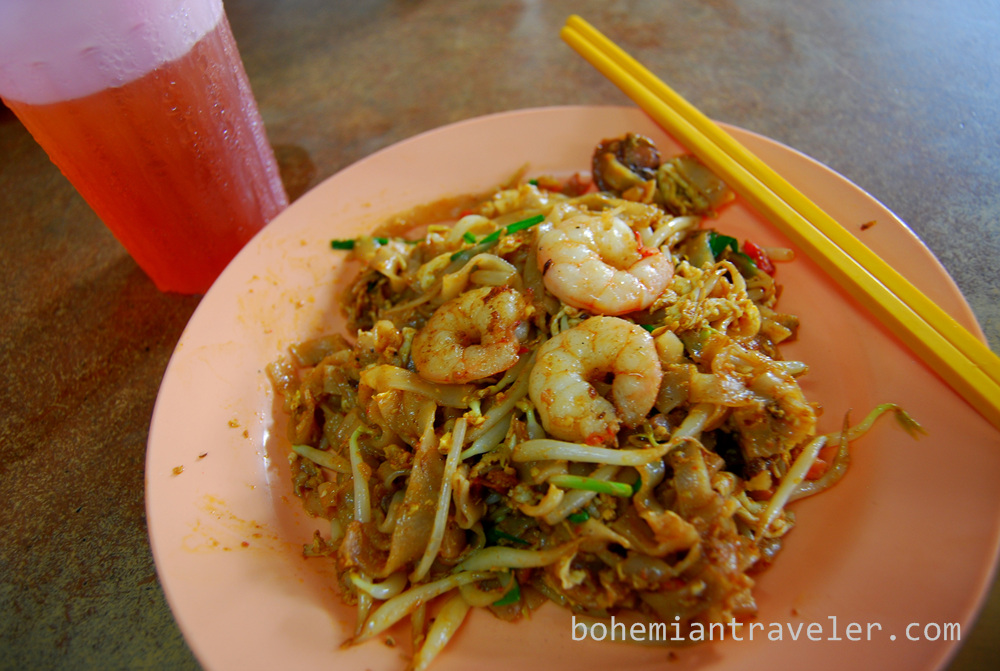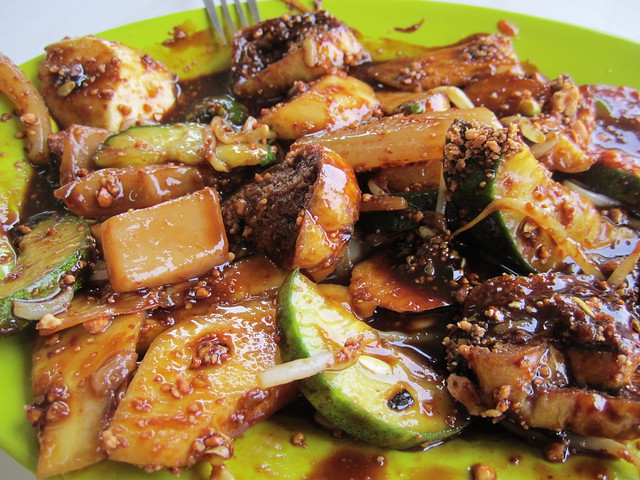Table of Contents
Your Guide to Malaysian Food
Malaysia is one of the most culturally diverse countries in the world. And this diversity translates wonderfully in its cuisine. Masterfully manipulating local ingredients with notable Chinese and Indian influence, Malaysian food is rich in flavor and tantalizing in its diversity.
Malaysian food explained
It is an impossible mission to try to taste every single Malaysian food if you are just traveling through. But fret not, below are 10 dishes to try that will give you not only a taste of this country’s delicious cuisine but a peek into the culture as well.
Nasi Lemak
Nasi Lemak, literally translates as “greasy rice”, and is the unofficial national dish of Malaysia. What makes Nasi Lemak so special is that the rice is soaked in coconut milk and the fragrant pandan leaf, and then steamed to give it an irresistible aroma.
Traditionally served wrapped in banana leaves, it is accompanied with a variety of side dishes. The most basic Nasi Lemak is served with spicy sambal (a mixture of chili paste, tamarind sauce and shrimp paste), slices of cucumber, boiled egg and roasted peanuts with fried anchovies. It is the quintessential Malaysian breakfast.
Nasi Lemak also comes with a main dish that can be any one of the following: chicken curry, beef rendang (beef stewed in coconut milk and spices), sambal sotong (spicy cuttlefish), fried fish in sambal sauce, fried chicken, etc., which makes it a more substantial meal for lunch and dinner.
This ubiquitous dish can easily be found anywhere in Malaysia; from humble street side stalls to fancy restaurants.
If you only want to try one dish in Malaysia, make it Nasi Lemak. Your Malaysian experience will be enriched by it, and you will find yourself wanting to come back, again and again.
Laksa
An exquisite Malaysian food, Laksa is gaining popularity internationally. It is a spicy noodle soup that delivers the “kick” your taste buds might be looking for.
A bowl of Laksa consists of noodles in a steamy, spicy broth with many types of garnishes. Most Malaysians like to have it for breakfast as the spiciness and the warm soup help wake them up better than anything else.
There are many types of Laksa in Malaysia, but the most popular are:
Nyonya Laksa – also known as Laksa Lemak, it’s a variant of Curry Laksa. This signature Peranakan dish (a glorious mixture of Chinese and Malay cooking) originates from Malacca. Nyonya Laksa is a firework of taste in a bowl of yellow noodle swimming in creamy coconut milk gravy, flavored by lemongrass, turmeric, and galangal. It is topped with bean curds, fish cakes, shrimp, and fresh herbs. The fish-based gravy is given a rich and slightly sweet flavor by the coconut milk. This mouth-watering concoction packs all the delights of Malaysian cuisine in one single bowl.
Penang Laksa – also known as Asam Laksa, it originates from the island of Penang. It is a bowl of spaghetti-sized rice vermicelli in a sour and spicy fish-based broth and garnished with finely sliced vegetables including onions, cucumber, red chilies, pineapple, lettuce, and finally mint. The mint juxtaposes perfectly with the sour and spicy fish broth. Nothing stimulates the appetite like a bowl of tangy Penang Laksa; this is Penang food at its best.
Sarawak Laksa – comes from Sarawak, on Borneo island. A widely loved dish in Sarawak but finding a good one in other parts of Malaysia is like finding a needle in a haystack. Sarawak Laksa is essentially rice vermicelli in a shrimp-based broth that is made to thicken with coconut milk. It is served with bean sprouts, boiled prawns and garnished with shredded chicken, slivers of egg omelet and fresh coriander. A thick sambal paste is usually served on the side with lime for added spiciness and tanginess. Sarawak Laksa achieves a delicious balance of tanginess and creaminess; it is not as sour as Penang Laksa and not as greasy as Nyonya Laksa. It is worth taking a trip to Sarawak just to have a taste of this heavenly dish.
Char Kuey Teow
Char Kuey Teow literally translated as “stir-fried flat rice noodle”. It is one of the perennial favorites in any hawker and street-side stalls in Malaysia and is considered a national favorite in Singapore.
Due to its popularity and versatility, many cooks and places have put their spin on it. But in essence, it is flat white rice noodle stir-fried over very high heat in a wok. It is usually stir-fried in soy sauce with eggs, bean sprouts, prawns, cockles, fish cakes, pork, chicken, etc. Like most things in Malaysia, chili and belacan (spicy prawn paste) can be added to spice up the dish.
The Chinese use pork lard to stir-fry the dish, giving it an irresistibly mouthwatering aroma. Most avid Char Kuey Teow lovers swear that nothing compares to the taste that pork lard cooked in high heat renders to the dish. However, the Malay use vegetable-based oil, catering to the non-pork-eating Muslims as well as vegetarians.
Char Kuey Teow is commonly eaten for breakfast, but most vendors/cooks will cook it fresh to order from morning till night. This is a timeless and widely-loved Malaysian street food.
Roti Canai
A classic breakfast dish, this Indian-inspired flatbread is made with flour, ghee (butter) and water. The whole concoction is then flattened, stretched and folded repeatedly, oiled and cooked on a heavily oiled hot plate grill, resulting in a sublimely fluffy piece of bread with a crispy exterior like a good croissant but soft, steaming and a little bit chewy on the inside.
It is usually served with curry on the side, where you dip the roti into, like fries with tomato sauce. And if you are a curry lover, you can order your roti drown in curry, like a stew.
Roni Canai is light enough to eat as a snack at any time of the day. But you can add egg, onion, or sardines to make it into a more substantial meal. Order a glass of teh tarik (see below) and you will have an authentic Malaysian eating experience.
Banana Leaf Rice
Banana Leaf Rice is a kaleidoscope of flavors. As the name implies, Banana Leaf Rice uses the leaves from the banana plant as a disposable plate. On it, white rice is served with an assortment of curries, vegetables, pickles, papadum (crispy fried dough) and other sour, salty and spicy condiments. The white rice, vegetables and curry gravies are refillable, so ask for a second helping if you want more.
This is traditionally a vegetarian dish, but nowadays you can get it with curried/fried meat or seafood. It is a popular dish for lunch; most restaurants serve it from late morning till early afternoon. However, finding it for dinner is not difficult in Malaysia.
This dish is usually eaten with the hands. You get to lick your fingers when you are done – a truly finger-licking good meal.
Oh, and don’t forget to fold the leaf towards you when you are done. This shows that you have had a great meal and it has satisfied you; while folding it outward signifies that it failed to impress you.
Bak Kut Teh
Literally translates as “meat bone tea”, Bak Kut Teh is pork (meaty ribs, lean mean or otherwise) slowly cooked in a broth of herbs, garlic, and spices for many hours. This is to extract the properties from the herbs and spices without destroying them, and for the meat to absorb them. Bean curds, cabbage/lettuce, and mushrooms are usually added into the broth as accompaniments.
Bak Kut Teh is usually eaten with steamed rice, as the intensive flavor in Bak Kut Teh is nicely toned down by the blandness of the rice.
A good Bak Kut Teh usually achieves a good balance of bittersweet and saltiness in its rich broth, which is said to have medicinal benefits. This strongly aromatic dark-colored broth makes some people’s mouth water, while others may find the herb flavor too strong for their liking.
Unlike the above five dishes, which are individual dishes, Bak Kut Teh is usually served in a bigger portion for a group sharing. It is a common meal for a whole family or a group of friends to enjoy.
Rojak
Rojak is a local salad of mixed fruit and vegetable, drenched in a dark sweet-sour sauce of prawn paste, tamarind, sugar and lime. Bean sprouts, bean curds, pineapple cubes, slices of cucumber, and sengkuang (jicama) are thrown into the mixture for texture and crunch. Then a generous sprinkle of crushed peanut and this sinfully delicious dish is ready to be served.
It is usually eaten as a side dish or an appetizer. Most people like to have it for afternoon tea, as it is substantial enough to satisfy the late afternoon hunger attack yet light enough not to spoil the appetite for dinner.
Rojak, meaning “mixture” in Malay, exemplifies the Malaysian culture like no other dish could. For the uninitiated, a bowl of Rojak could look like someone just throwing random things into a bowl; and Malaysian society is kind of like that if you haven’t spent enough time in the country: the cultural mixture of Malay, Chinese, Indian and other races could seem a little incoherent but it is in this mixture that Malaysia thrives and it is mouthwateringly manifested in its cuisine.
Cendol
Cendol is a traditional dessert made with shaved ice. It has evolved from the humble ice ball soaked with syrup to be the ice mountain served in a bowl, drizzled with coconut milk, gula melaka (palm sugar), sweet corn, red beans, palm seeds, noodle jellies, glass jellies and anything else the vendor fancies.
The unique ingredient here is the noodle jelly. It is a chewy, pandan-flavored, worm-like jelly that gives this dessert its name. And the gula melaka gives it a distinctive sweet taste.
The way to eat it is to stir all the ingredients around and wait for the ice to melt. When the bowl of ice has turned into a bowl of drink with ice (which you don’t have to wait long in Malaysian heat) then it’s the best time to dig in; as the intensely sweet syrup will then be watered-down by the melted ice.
A bowl of ice-cold Cendol is a welcomed tonic in a place like Malaysia, where the temperature hovers around 33°C. This is the ultimate Malaysian dessert.
Essentially a dessert, a bowl of Cendol with a plate of Rojak is a match made in heaven.
Kaya Toast
Kaya (means rich in Malay) is a sweet and fragrant coconut custard jam; quite similar in taste and texture to the dulce de leche and arequipe found in South America. The jam is made from coconut milk, eggs, sugar and pandan leaf.
Kaya toast is made with two slices of bread: one is spread with Kaya, the other is slathered with butter. Then the two are “married” to create an orgasmic bite. In old coffee shops, this is called roti kahwin, which means married bread.
It is popular for breakfast as well as tea time. If you can find an old coffee shop where they still use porcelain cups, order roti kahwin with a cup of hot local black coffee and you will be transported back to colonial Malaysia. As this was the everyday breakfast for the ordinary people in Malaysia in the 1950s to 1970s.
Teh Tarik
This is not food but Teh Tarik is so inherently Malaysian that it had to be included. Teh Tarik literally translates to “pulled tea”, and is drunk all over Malaysia and all day long. Teh Tarik is an Indian beverage that Malaysia has adopted, refined, and made her own.
Strongly brewed black tea is sweetened with condensed milk. Then it is poured back and forth repeatedly between two jugs from a height, giving it a thick and frothy top. The pouring back and forth cools the tea and gives it a distinctive consistency and texture.
For many foreigners, watching the brewer “pull” the tea without spilling a drop is a novelty. And in recent years, this has become an art form where competitions are held to see who has the best showmanship and who can “pull” the best glass of Teh Tarik.
Teh Tarik is intricately linked to the Malaysian culture. Malaysians gather at street-side stalls, coffee shops to socialize, gossip, watch football matches while sipping their Teh Tarik.
Teh Tarik, along with Nasi Lemak, has been recognized by the government as part of the food and beverage heritage of Malaysia.
***
With such wonderful cuisine, it’s no wonder that Malaysia is an eating culture. You can find almost any food at any time of day. So go on, experience Malaysia through your palate!















Never had Malaysian food before but that looks so good! My favorite dishes are noodle soups so I need to try the Laksa sometime in my life!
Pingback: How to order local coffee in Malaysia | wander2nowhere
Thank you Samantha. You should come to Malaysia and try Laksa. It’s worth the journey 🙂
Pingback: Pre-Reading and Highlights for the Malaysia Singapore Trip
Pingback: Top 10 countries | wander2nowhere